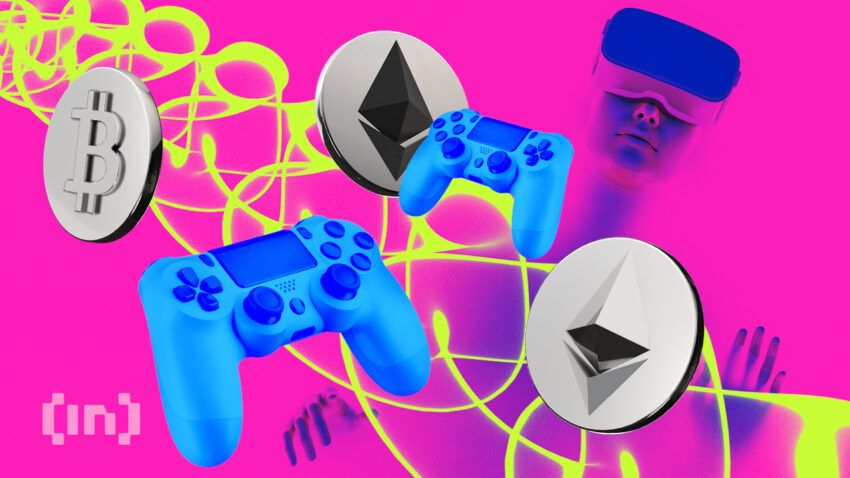Despite a recent wave of criticism, the metaverse is no lost cause. And the key to unlocking this potential lies in the gaming industry. Here’s why play-to-earn metaverse games will be instrumental in transforming hype into reality and facilitating revolutionary user experiences.
- The metaverse and blockchain gaming: natural affinities
- Fostering a player-first ecosystem through in-game asset ownership
- The early-adopter tendencies of gamers
- Gaming in the metaverse could be a revolutionary user experience
- Converting the metaverse from hype to reality with blockchain gaming
- Frequently asked questions
- About the author
The metaverse and blockchain gaming: natural affinities

When Facebook changed its name to Meta in late 2021, many believed 2022 was poised to pave the way to a not-so-distant future in the metaverse. The hype cycle settled as the months rolled on, and Meta’s image of Mark Zuckerberg by the Eiffel Tower in the metaverse went viral. Skepticism, rather than widespread adoption, dominated the reputation of the metaverse.
That said, the metaverse still prevailed in public discourse despite the economic downturn of the wider technology industry in 2022, with the term being shortlisted for Oxford English Dictionary’s Word of The Year. As we’ve alluded to above, the metaverse is here to stay in one form or another.
Some critics remain convinced that the metaverse is doomed to recede into the annals of the internet. Yet Forbes continues to hail the metaverse as one of the top ten trends to be ready for in 2023. Data shows that 69% of users believe metaverse entertainment will transform our social habits and has the potential to reshape our daily lives.
More specifically, blockchain gaming will play a pivotal role in paving the way for a new generation of metaverse users by way of:
- Fostering a player-first ecosystem through in-game asset ownership
- The early-adopter tendencies of gamers
- A revolutionary user experience
Fostering a player-first ecosystem through in-game asset ownership
Implementing NFTs into a game’s economy offers a revolutionary new system of digital asset ownership. In traditional games, proof of ownership lies under the control of gaming companies rather than users. When a gamer purchases an item in a game, the product becomes obsolete upon a player’s exit. To further complicate matters, many of the most desirable objects offered in games must be paid for with fiat currency rather than a game’s virtual currency. This means that when a player has completed a game or a new version is released, items that players have spent their hard-earned money on become essentially worthless.
Rather than binding players to one specific game, the interoperable capabilities of NFTs allow gamers to transfer items from one game to another. This wholeheartedly transforms the traditional in-game asset ownership model. By allowing users to own a piece of the game that they are passionate about and transfer it across a variety of platforms, no longer will in-game assets cease to be useful upon a game’s completion. What’s more, this also grants developers a range of interesting options for how they approach NFT implementation, which in turn offers gamers assets that can outlive and even outgrow their usage in any game. This allows for the development of a digital identity over time across multiple games. The resulting flexibility will lower the barriers to entry for gamers to invest further in their respective gaming communities.
This is not to say that asset ownership via NFTs does not come with its own challenges. However, these pale compared to the unprecedented number of interesting use cases it gives rise to.
Branding in-game assets via NFT
Brands can capitalize on this ownership model in their marketing and sales efforts. Companies can offer branded in-game assets, buy virtual plots of land for marketing campaigns, and even produce digital twins of their physical products so that one can own something both in-game and in real life.
Examples of this have already been brought to life by Nike with .Swoosh, Adidas with the capsule collection in collaboration with Bored Ape Yacht Club, Pixel Vault, and GMoney, to name but a few. Thus providing an innovative way through which gamers can express their individuality in games while also allowing brands to foster brand loyalty.
Secondary sales and royalties in-game
Furthermore, NFT ownership enables secondary sales of tokenized in-game assets on NFT marketplaces. This allows for royalties to automatically accrue to the original creator and for the intrinsic value of gaming assets to increase with demand. Should one decide to ‘hang up their remote’, one can recoup some of the time and effort poured into a game by selling one’s in-game inventory.
The range of benefits offered to users through in-game asset ownership by way of NFTs thus provides a major incentive for gamers to transition to blockchain gaming. And the result? An industry worth $220 billion USD stands on the doorstep of the metaverse.
The early-adopter tendencies of gamers

Since its inception, the metaverse has faced the hurdle of widespread adoption. This obstacle may not be as prevalent amongst gamers, as they are more likely to engage with new technology relative to non-gamers. Specifically, they tend to be more likely to adopt new technology in its infancy.
Key onboarding metrics have already begun to prove this theory. DappRadar found that blockchain games registered 912,000 Unique Active Wallets (UAWs) in Q3 2022. In-game NFTs generated sales of $2.2 billion USD in that time frame, accounting for 22% of overall NFT trading.
Additionally, blockchain gaming was one of the few verticals within the blockchain ecosystem that showed promise in 2022 amidst an otherwise tumultuous year for the broader industry.
The global blockchain gaming market was valued at $4.6 billion USD in 2022, with predictions forecasting potential growth of up to $65.7 billion USD by 2027. This indicates the potential for the blockchain gaming industry to leverage the wider global gaming market further.
Gaming in the metaverse could be a revolutionary user experience

Developments in virtual reality (VR), augmented reality (AR), and artificial intelligence (AI) have sparked debates around the world. The creative capabilities of generative AI applications like ChatGPT and MidJourney have taken the internet by storm. When coupled with the benefits of in-game asset ownership, these advancements will allow blockchain gaming to offer user experiences not currently available in traditional gaming.
Perhaps one of the most interesting developments in AI is the improvement of non-playable characters (NPCs). Owing to advancements in AI technology, non-deterministic AI, and techniques such as pattern and reinforcement learning, in-game ‘enemies’ are becoming increasingly capable of intelligently learning from their own actions, as well as the actions of the player. This has facilitated the creation of less formulaic and predictable games, in turn making them more realistic.
When added to the in-game asset ownership and associated individuality that this allows players to express, VR and AR technology makes blockchain gaming increasingly attractive. This is particularly the case as we shift away from traditional screen-based gaming models.
Gamers will be able to own and use items across various platforms and experience this in an immersive and realistic environment. This will enable the creation of a cutting-edge experience that gamers cannot access with traditional games. This gap will widen further as the industry matures, magnetizing the traditional gaming community to build and play in the metaverse.
Converting the metaverse from hype to reality with blockchain gaming
The key to converting the metaverse from hype to reality will be onboarding a consistent stream of users. In spite of the economic downturn, the traditional gaming market is expected to show an annual growth rate of 6.52%, with a projected market volume of $285 billion USD by 2027. With a business case backed by growth metrics, many companies have already begun to develop strategies to leverage the gaming industry to further their business objectives. For instance, in April of 2022, Tiffany & Co. signed a multi-year global partnership with League of Legends Esports.
Similarly, gamers have the ability to lead the adoption curve of the metaverse through blockchain gaming by normalizing it in the peer groups and industries that they engage with.
Frequently asked questions
What is the metaverse?
What are blockchain games?
What are in-game assets?
How does AI work in gaming?
About the author

Tim is the Co-Founder and CEO of Venly, a developer-friendly blockchain technology provider specialized in wallet, NFT and marketplace solutions. He’s been passionate about blockchain since 2014 and active since 2016. He’s building Venly to help web2 businesses embrace web3 technology as he firmly believes that the way we do business will drastically change due to the innovation. Tim has a Master’s degree in Business Science and earned a professional degree in Business Analysis at The Master Labs. He loves to learn, play tennis, share ideas, and foster great relationships.
Disclaimer
In line with the Trust Project guidelines, the educational content on this website is offered in good faith and for general information purposes only. BeInCrypto prioritizes providing high-quality information, taking the time to research and create informative content for readers. While partners may reward the company with commissions for placements in articles, these commissions do not influence the unbiased, honest, and helpful content creation process. Any action taken by the reader based on this information is strictly at their own risk. Please note that our Terms and Conditions, Privacy Policy, and Disclaimers have been updated.





